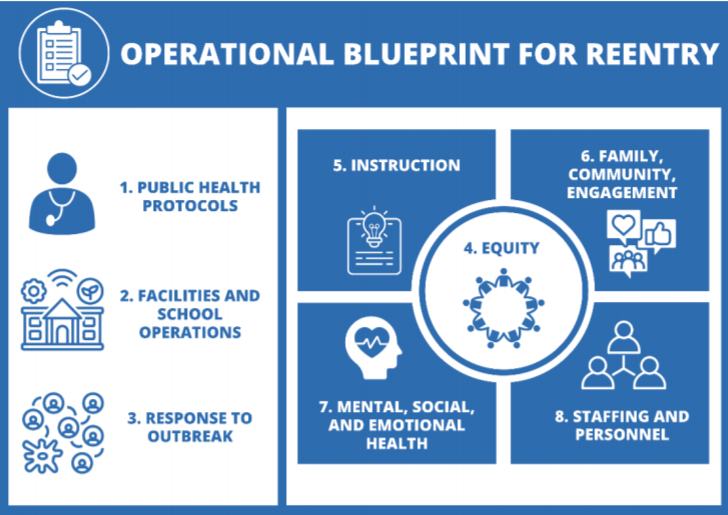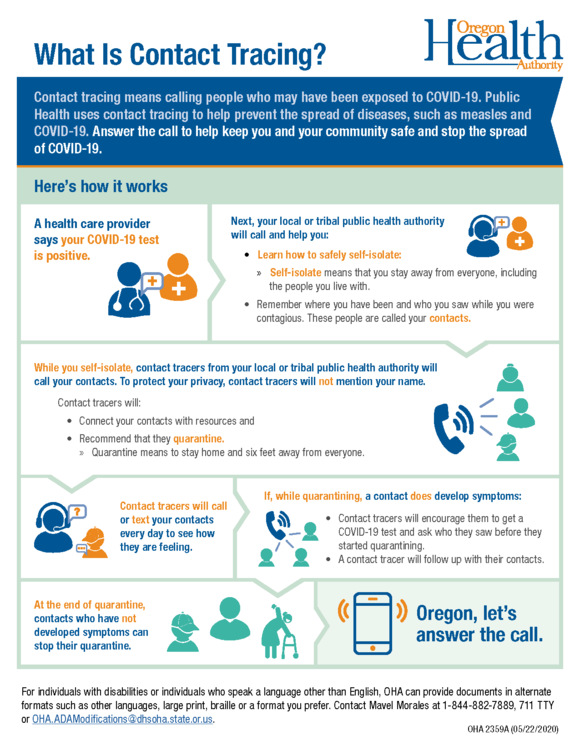|
Greetings:
Today, Governor Kate Brown and the Oregon Department of Education announced updated school re-opening metrics for the 2020-2021 school year. Within these metrics is clear guidance for when in-person instruction will be allowable under the Ready Schools, Safe Learners guidance. Oregon is taking a measured approach based on science and public health data to limit the spread of coronavirus transmission.
That is why it is imperative that we all do the work that is needed to mitigate transmission rates so that our students can return to the classroom. As we continue to navigate the times ahead, every one of us must follow the basics that we know have an impact on limiting infections: wear masks, maintain physical distancing, wash your hands, and avoid gatherings (especially indoors) with people outside your household. Below is some helpful information provided by the Oregon Department of Education explaining key changes to school reopening metrics.

Key Changes to School Reopening Metrics
Measurement period, 2-week average
County metrics will be measured for one, 2-week period instead of three 1-week periods. Particularly in small counties with low case counts, a small change in the number of cases in one week could have prevented schools from opening under the previous metrics.
Remove statewide positivity metric
Holding all districts to a statewide positivity metric has led some schools to remain closed even when community metrics are at safer level—now only a county’s positivity rate will be used.
Elementary School (K-6)
Elementary schools provide the best opportunity for maintaining small cohorts. This group of students also has the most difficulty with comprehensive distance learning and individual study—young students are still learning to read, and can still have difficulty reading to learn. Under previous metrics, only K-3 students were allowed to return to school first, meaning that elementary schools could reopen in some districts but 4th, 5th, and 6th graders could not return to their school. Under new guidance, the Oregon Health Authority (OHA) and the Oregon Department of Education (ODE) have determined that students in grade K-6 can return so long as strict protocols are followed and with consultation with local public health.
Local decision-making
No metrics can account for all situations, particularly in a state as large and diverse as Oregon. In addition, school districts need time to plan to shift from distance learning to in-person instruction, or back if necessary. Under the new school metrics, school districts, in consultation with local public health, will make final decisions about when schools can move to in-person instruction. The Oregon Department of Education (ODE) and the Oregon Health Authority (OHA) will advise school districts during that process, and will confirm with school districts when their county has satisfied the required metrics for the return to in-person instruction. ODE, OHA, and Oregon OSHA will work together to ensure that school districts are meeting state standards for reducing risk of transmission of COVID-19 in the learning and working environment for students and staff.
Oregon Health Authority Update
The Oregon Health Authority released its COVID-19 Weekly Report. During the week of Monday, October 19, through Sunday, October 25, OHA recorded 2,642 new cases of COVID-19. That is a 14% increase from the previous week and a record-high for the pandemic. Here are some developments:
- The number of newly tested Oregonians rose to 31,448 and the percentage of positive tests held steady at 6.5%. Twenty-seven Oregonians were reported to have died in association with COVID-19—compared to 25 the previous week and 143 were hospitalized.
- People aged 20 to 49 accounted for the largest percentage of infection at 56%, despite accounting for 39% of the total population. Persons under 30 accounted for 37 percent of the cases.
- People over 80 accounted for 51% of COVID-19 associated deaths and people over 70 accounted for 75% of deaths associated with the illness. For daily updates, you can sign up for OHA’s daily community update email, if you haven’t already.
- You can sign up for OHA’s daily community updates here.
Multnomah County Joins COVID-19 Watch List
Multnomah County was recently added to the COVID-19 Watch List. Counties are placed on the watchlist when there is a sporadic case rate of ≥ 50 per 100,000 in the last two weeks and the county has > 5 sporadic cases in the last two weeks. Sporadic cases are those cases that cannot be traced to a source, which indicates community spread. Counties remain on the watchlist for a minimum of three weeks and until their sporadic case count drops below 50 per 100,000 or ≤ 5 cases in the previous two weeks. The watchlist helps to prioritize resources and assistance to the counties that are seeing the broadest spread of COVID-19. You can find more information about this here.
Oregon Joins COVID-19 Vaccine Workgroup
Oregon recently joined Washington and Nevada in California’s COVID-19 Scientific Safety Review Workgroup. The purpose of this workgroup is to independently review the safety and efficacy of COVID-19 vaccines that are approved by the FDA for distribution. Oregon will also work to identify public health experts to join California’s workgroup. This is a meaningful partnership that will help aid Oregon’s coronavirus response efforts. You can find more information about the workgroup here.
Contact Tracing Information
Contact tracing stops the spread of infections by finding those who may have been exposed and asking them to stay home and watch for signs of infection. After someone tests positive for COVID-19, a public health worker calls to ask where the person has been, and offers information and support. Your information will be kept confidential. Contact tracers never ask for your social security number, your immigration status, credit card, banking or billing information. If someone asks for any of these, hang up.
Please answer the call. If a worker calls, you’ll learn:
- Symptoms to watch for
- How to get tested if you get sick
- How to avoid spreading the coronavirus
- How to care for yourself and others, where to find resources
- Where to find resources

Please reach out to my office if you have any additional questions, or if there’s anything you think I could help with.
Sincerely,
 Representative Barbara Smith Warner
House District 45
email: Rep.BarbaraSmithWarner@oregonlegislature.gov I phone: 503-986-1445
address: 900 Court St NE, H-295, Salem, OR 97301
website: http://www.oregonlegislature.gov/smithwarner
|